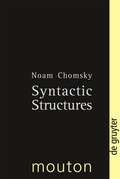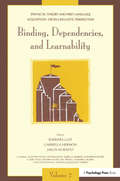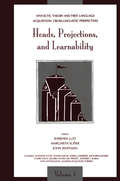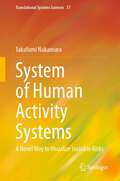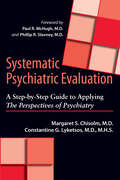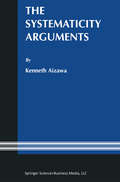- Table View
- List View
Syntactic Theory and First Language Acquisition: Cross-linguistic Perspectives -- Volume 1: Heads, Projections, and Learnability -- Volume 2: Binding, Dependencies, and Learnability
by Barbara Lust Gabriella Hermon Jaklin Kornfilt Suzanne Flynn Shyam Kapur Isabella Barbier Katharina Boser Claire Foley Zelmira Nuñez del Prado Edward J. Rubin Lynn Santelmann Jacqueline ToribioUniversal Grammar (UG) is a theory of both the fundamental principles for all possible languages and the language faculty in the "initial state" of the human organism. These two volumes approach the study of UG by joint, tightly linked studies of both linguistic theory and human competence for language acquisition. In particular, the volumes collect comparable studies across a number of different languages, carefully analyzed by a wide range of international scholars. The issues surrounding cross-linguistic variation in "Heads, Projections, and Learnability" (Volume 1) and in "Binding, Dependencies, and Learnability" (Volume 2) are arguably the most fundamental in UG. How can principles of grammar be learned by general learning theory? What is biologically programmed in the human species in order to guarantee their learnability? What is the true linguistic representation for these areas of language knowledge? What universals exist across languages? The two volumes summarize the most critical current proposals in each area, and offer both theoretical and empirical evidence bearing on them. Research on first language acquisition and formal learnability theory is placed at the center of debates relative to linguistic theory in each area. The convergence of research across several different disciplines -- linguistics, developmental psychology, and computer science -- represented in these volumes provides a paradigm example of cognitive science.
Syntactic Theory and First Language Acquisition: Cross-linguistic Perspectives -- Volume 1: Heads, Projections, and Learnability -- Volume 2: Binding, Dependencies, and Learnability
by Barbara Lust Margarita Suñer John Whitman Suzanne Flynn Shyam Kapur Isabella Barbier Katharina Boser Claire Foley Zelmira Nuñez del Prado Edward J. Rubin Lynn Santelmann Almeida Jacqueline ToribioUniversal Grammar (UG) is a theory of both the fundamental principles for all possible languages and the language faculty in the "initial state" of the human organism. These two volumes approach the study of UG by joint, tightly linked studies of both linguistic theory and human competence for language acquisition. In particular, the volumes collect comparable studies across a number of different languages, carefully analyzed by a wide range of international scholars. The issues surrounding cross-linguistic variation in "Heads, Projections, and Learnability" (Volume 1) and in "Binding, Dependencies, and Learnability" (Volume 2) are arguably the most fundamental in UG. How can principles of grammar be learned by general learning theory? What is biologically programmed in the human species in order to guarantee their learnability? What is the true linguistic representation for these areas of language knowledge? What universals exist across languages? The two volumes summarize the most critical current proposals in each area, and offer both theoretical and empirical evidence bearing on them. Research on first language acquisition and formal learnability theory is placed at the center of debates relative to linguistic theory in each area. The convergence of research across several different disciplines -- linguistics, developmental psychology, and computer science -- represented in these volumes provides a paradigm example of cognitive science.
Syntactic Theory and First Language Acquisition: Cross-linguistic Perspectives -- Volume 1: Heads, Projections, and Learnability -- Volume 2: Binding, Dependencies, and Learnability
by Vol. 1 Barbara Lust Margarita Su¤er John Whitman Vol. 2 Barbara Lust Gabriella HermonUniversal Grammar (UG) is a theory of both the fundamental principles for all possible languages and the language faculty in the "initial state" of the human organism. These two volumes approach the study of UG by joint, tightly linked studies of both linguistic theory and human competence for language acquisition. In particular, the volumes collect comparable studies across a number of different languages, carefully analyzed by a wide range of international scholars. The issues surrounding cross-linguistic variation in "Heads, Projections, and Learnability" (Volume 1) and in "Binding, Dependencies, and Learnability" (Volume 2) are arguably the most fundamental in UG. How can principles of grammar be learned by general learning theory? What is biologically programmed in the human species in order to guarantee their learnability? What is the true linguistic representation for these areas of language knowledge? What universals exist across languages? The two volumes summarize the most critical current proposals in each area, and offer both theoretical and empirical evidence bearing on them. Research on first language acquisition and formal learnability theory is placed at the center of debates relative to linguistic theory in each area. The convergence of research across several different disciplines -- linguistics, developmental psychology, and computer science -- represented in these volumes provides a paradigm example of cognitive science.
Syntactic Theory and First Language Acquisition: Cross-linguistic Perspectives -- Volume 1: Heads, Projections, and Learnability -- Volume 2: Binding, Dependencies, and Learnability
by Vol. 1 Barbara Lust Margarita Su¤er John Whitman Vol. 2 Barbara Lust Gabriella HermonUniversal Grammar (UG) is a theory of both the fundamental principles for all possible languages and the language faculty in the "initial state" of the human organism. These two volumes approach the study of UG by joint, tightly linked studies of both linguistic theory and human competence for language acquisition. In particular, the volumes collect comparable studies across a number of different languages, carefully analyzed by a wide range of international scholars. The issues surrounding cross-linguistic variation in "Heads, Projections, and Learnability" (Volume 1) and in "Binding, Dependencies, and Learnability" (Volume 2) are arguably the most fundamental in UG. How can principles of grammar be learned by general learning theory? What is biologically programmed in the human species in order to guarantee their learnability? What is the true linguistic representation for these areas of language knowledge? What universals exist across languages? The two volumes summarize the most critical current proposals in each area, and offer both theoretical and empirical evidence bearing on them. Research on first language acquisition and formal learnability theory is placed at the center of debates relative to linguistic theory in each area. The convergence of research across several different disciplines -- linguistics, developmental psychology, and computer science -- represented in these volumes provides a paradigm example of cognitive science.
The Synthesis of Self: Volume 2 It All Depends on How You Look at It Development of Pathology in the Cohesive Disorders
by Lee S. CohenThe oedipal situation involves much more than an instinctual at titude toward a prohibited object giving expression to unconscious wishes. It introduces a whole new way of perceiving the internal and external world and an entirely different orientation to the myriad of life's experiences. A great deal of structural develop ment, requiring the negotiation of a sequence of early developmen tal tasks, has to have taken place before it is possible to encompass the complex demands of an oedipal attitude. When these early steps are not negotiated, although genital instinctual impulses may be manifested, the structural alignments necessary to enter into an oedipal position cannot be effected and the intrapsychic con flicts it engenders are not encountered. The thrust of early develop ment has made it essential for a narcissistic perspective to be adopted toward all stimuli and all relationships in order to enable All attachments must of necessity be continuing self-expansion. based upon the narcissistic supplies they contain, which ultimately lead to increasing levels of independence, self-differentiation, and individuation. It is precisely when the component instincts are con solidated into a genital drive that a narcissistic orientation can no longer incorporate the representation of experiences needed for the full realization of self-potentials. Were stimuli to only possess sig nificance in regard to their narcissistically enhancing attributes, the resulting dependence upon the external world would run counter to the thrust for independence and autonomy.
The Synthesis of Self: Volume 1 the I of Consciousness Development from Birth to Maturity
by R. M. MendelsohnA psychoanalyst, through training and experience, directs the en tire focus of his attention to registering and internalizing the in put of a patient's communications, listening intently for their implied meanings. It is only by umaveling the mysteries of an un conscious realm of mental activity that it becomes possible to fully comprehend the way in which mental productions are finally ob servable. The psychoanalyst's total personality is the listening in strument, and the messages emanating from this hidden sector most clearly heard, deciphered, and understood are those most resonant with the contents of the psychoanalyst's unconscious. It is probable that a variety of psychoanalysts adopting a listening posture with a given patient would hear and understand a mul tiplicity of different meanings. Over the years, sensitive, well trained psychoanalytic investigators have formulated concepts con cerning mental functioning from disparate and often opposing points of view. These contradictory ideas are offered from a ba sic theoretical foundation placing unconscious mental events as the most important force shaping human experience. Divergent opin ions may at times appear irreconcilable and then serve as the grounds for developing a separate psychoanalytic school of thought. It is not surprising that an exploration of unseen powerful and regressive forces, by a group of scientists with unique in dividual experiences, would yield insights sensitively attuned to a wide variety of important factors determining human develop ment and behavior.
Synthesizing Nature-nurture: Prenatal Roots of Instinctive Behavior (Distinguished Lecture Series)
by Gilbert GottliebThis volume provides a primarily nontechnical summary of experimental and theoretical work conducted over the course of 35 years which resulted in a developmental framework capable of integrating causal influences at the genetic, neural, behavioral, and ecological levels of analysis. It describes novel solutions to the nature-nurture problem at both the empirical and theoretical levels. Following field observations, laboratory experiments led to the discovery of the nonobvious prenatal experiential basis of instinctive behavior in two species--ground-nesting mallard ducklings and hole-nesting wood ducklings. This work also describes the experiences that lead to the rigid canalization of behavioral development as well as the social and sensory experiences that favor the continuance of flexibility. The author also describes in detail a developmental psychobiological systems view that supports a behaviorally and psychologically mediated pathway to evolutionary change in humans and other species. Written in a way that is readable to even the nonspecialist, the text is accompanied by numerous photographs that illuminate and add personal meaning to the written words. Readers will be engaged by the emphasis on the human aspect of the scientific enterprise.
Synthesizing Nature-nurture: Prenatal Roots of Instinctive Behavior (Distinguished Lecture Series)
by Gilbert GottliebThis volume provides a primarily nontechnical summary of experimental and theoretical work conducted over the course of 35 years which resulted in a developmental framework capable of integrating causal influences at the genetic, neural, behavioral, and ecological levels of analysis. It describes novel solutions to the nature-nurture problem at both the empirical and theoretical levels. Following field observations, laboratory experiments led to the discovery of the nonobvious prenatal experiential basis of instinctive behavior in two species--ground-nesting mallard ducklings and hole-nesting wood ducklings. This work also describes the experiences that lead to the rigid canalization of behavioral development as well as the social and sensory experiences that favor the continuance of flexibility. The author also describes in detail a developmental psychobiological systems view that supports a behaviorally and psychologically mediated pathway to evolutionary change in humans and other species. Written in a way that is readable to even the nonspecialist, the text is accompanied by numerous photographs that illuminate and add personal meaning to the written words. Readers will be engaged by the emphasis on the human aspect of the scientific enterprise.
Synthetic Microstructures in Biological Research
by M. Peckerar J. M. SchnurThe Third International Conference on Synthetic Microstructures in Biological Research (SMIBR) was held in Williamsburg, Virginia, September 9-12, 1991. This book represents the compilation of many of the papers and posters presented at the meeting. Publications resulting from previous SMIBR meetings held at Airlie House, Airlie, Virginia (March 24-26, 1986 and March 20-23, 1988) can be obtained from the Institute of Electrical and Electronic Engineers, Inc. (IEEE) Service Center (908 562-5418). The purpose of these conferences is to provide an interface between the engineering community and those at the cutting edge of biological and related material science. The overriding motive for assembling representatives from these diverse disciplines is clear. Engineers, even in 1986, could manipulate materials over dimensional scales on the order of those critical to biological systems. The devices that emerge from these manipulations could then be tailored to monitor system function more directly with significantly more localization than ever before. Thus, one important goal of the meetings is to provide the detailed specifications required for effective interfacing of devices with biological systems under investiga tion.
Syphilis, Puritanism and Witch Hunts: Historical Explanations in the Light of Medicine and Psychoanalysis with a Forecast about Aids
by Stanislav AndreskiSystem-Aufstellungen und ihre naturwissenschaftliche Begründung: Grundlage für eine innovative Methode zur Entscheidungsfindung in der Unternehmensführung (Systemaufstellungen in Wissenschaft und Praxis)
by Thomas GehlertIn dieser Open-Access-Publikation liefert Thomas Gehlert eine konsistente, auf aktuellen Experimenten und Theorien basierte, fundierte natur- und neurowissenschaftliche Theorie, die den zugrundeliegenden Prozess bei Intuition (Bauchgefühl) und System-Aufstellung beschreiben kann. Damit schließt er eine theoretische Lücke, die die breite Akzeptanz unzähliger experimenteller Ergebnisse in Entscheidungstheorie- und Intuitionsforschung verhinderte. Darauf aufbauend darf die System-Aufstellung als legitimierte Methode im Kontext von Unternehmensführung, strategischem Management und Entscheidungsfindung angesehen werden.
System Familie und Geistige Behinderung
by Maria T. SchubertDas Buch stellt neue wissenschaftliche Erkenntnisse der systemisch-strukturellen Familienforschung im Bereich der Behindertenarbeit vor. Es behandelt die Frage, ob bei Familien mit geistig behinderten Kindern vermehrt innerfamiliäre Schwierigkeiten, Dysfunktionalitäten und typische Fehlentwicklungen nachweisbar sind. Die Untersuchung wendet zwei, im deutschsprachigen Raum neue familiendiagnostische Instrumente an und vergleicht die Ergebnisse mit denen einer Kontrollgruppe sogenannter Normalfamilien. Ziel des Buches ist es, auf der Grundlage wissenschaftlich gesicherter Aussagen zu einem differenzierten Verständnis von Familien mit geistig behinderten Kindern beizutragen. Dem Wissenschaftler und Praktiker der Behindertenarbeit wird ein Modell über die Familienstruktur von Familien mit behinderten Kindern in die Hand gegeben, das er in Forschung und Praxis anwenden und validieren kann. System Familie und Geistige Behinderung, zwei aktuelle und vielbehandelte Themen, werden so in einer wissenschaftlichen Studie miteinander verknüpft.
System of Human Activity Systems: A Novel Way to Visualize Invisible Risks (Translational Systems Sciences #37)
by Takafumi NakamuraThis book has unique features that set it apart from conventional books on the prevention of system failures in that it provides a method that views human activities from a meta-methodological perspective based upon an inter-disciplinary understanding of human activities. With these characteristics, the book also proposes a common methodological basis to apply to various problems surrounding society today such as an aging social infrastructure; the safety of food, medicine, and public transportation; and the creation of sustainable electricity and cybersecurity. Furthermore, since the failure of human activities is expressed in a three-dimensional space and the topological metrics are implemented, the failure trajectories can be quantitatively monitored in time series to take effective preventive measures. Considering the implementation of the topological metrics, the causes of each failure are classified into two dimensions of the degree of coupling between system elements and the interaction between the target system and the external environment. Owing to the nature of the introduction of topological metrics, all individual and diverse systems can share general topological metrics. Consequently, understanding various failures over cross-industries is possible with the use of common meta-systemic language and mutual learning between different industries, and the solution of social problems can be effectively achieved. A system of system failures (SOSF) proposed and confirmed the effectiveness of this meta-methodology for information and communication technologies (ICT) systems and the SOSF is extended to human activity systems (SOHAS: system of human activity systems) as a whole. Therefore, the SOHAS becomes an academic foundation for theoretical research on meta-methodology, and it has an impact on practitioners to prevent system failures by accumulating knowledge of failures and learning from other industries.
A System of Pleas: Social Sciences Contributions to the Real Legal System (American Psychology-Law Society Series)
by Allison D. Redlich Vanessa A. EdkinsOver 95% of criminal convictions are by guilty plea. Trials are the rarity, and while much has been written on jury decision making and various parts of the trial process, the field has been largely silent on the practice that is most likely to affect an individual charged with a crime: plea bargaining. A System of Pleas: Social Science's Contributions to the Real Legal System brings together into one resource the burgeoning body of research on plea bargaining. Drawing attention to the fact that convictions today are nearly synonymous with guilty pleas, this contributed volume begins with an overview and history of plea bargaining, with chapters focusing on defendants, defense attorneys and prosecutors and plea bargains; influences on plea decision-making, including race, juvenile justice system involvement, and innocence; and the results of a "system of pleas", such as sentencing disparities and mass incarceration, collateral consequences, and disenfranchisement. A concluding chapter by the volume's editors examines ways to move forward within an entrenched system. An excellent reference tool for furthering both research and practice, A System of Pleas is a must-have for academics and legal professionals interested in the fields of criminal justice, psychology and law, and related disciplines.
A System of Pleas: Social Sciences Contributions to the Real Legal System (American Psychology-Law Society Series)
Over 95% of criminal convictions are by guilty plea. Trials are the rarity, and while much has been written on jury decision making and various parts of the trial process, the field has been largely silent on the practice that is most likely to affect an individual charged with a crime: plea bargaining. A System of Pleas: Social Science's Contributions to the Real Legal System brings together into one resource the burgeoning body of research on plea bargaining. Drawing attention to the fact that convictions today are nearly synonymous with guilty pleas, this contributed volume begins with an overview and history of plea bargaining, with chapters focusing on defendants, defense attorneys and prosecutors and plea bargains; influences on plea decision-making, including race, juvenile justice system involvement, and innocence; and the results of a "system of pleas", such as sentencing disparities and mass incarceration, collateral consequences, and disenfranchisement. A concluding chapter by the volume's editors examines ways to move forward within an entrenched system. An excellent reference tool for furthering both research and practice, A System of Pleas is a must-have for academics and legal professionals interested in the fields of criminal justice, psychology and law, and related disciplines.
System ohne Psyche: zur Kritik der Pragmatischen Kommunikationstheorie und ihrer Anwendungen (Beiträge zur psychologischen Forschung #11)
by Karl J. MeisterSystem Theories and A Priori Aspects of Perception (ISSN #Volume 126)
by J. Scott JordanThis book takes as a starting point, John Dewey's article, The Reflex Arc Concept in Psychology, in which Dewey was calling for, in short, the utilisation of systems theories within psychology, theories of behaviour that capture its nature as a vastly-complex dynamic coordination of nested coordinations. This line of research was neglected as American psychology migrated towards behaviourism, where perception came to be thought of as being both a neural response to an external stimulus and a mediating neural stimulus leading to, or causing a muscular response. As such, perception becomes a question of how it is the perceiver creates neural representations of the physical world. Gestalt psychology, on the other hand, focused on perception itself, utilising the term Phenomenological Field; a term that elegantly nests perception and the organism within their respective, as well as relative, levels of organisation. With the development of servo-mechanisms during the second world war, systems theory began to take on momentum within psychology, and then in the 1970s William T Powers brought the notion of servo-control to perception in his book, Behavior: The Control of Perception. Since then, scientists have come to see nature not as linear chain of contingent cause-effect relationships, but rather, as a non linear, unpredictable nesting of self referential, emergent coordinations, best described as Chaos theory. The implications for perception are astounding, while maintaining the double-aspect nature of perception espoused by the Gestalt psychologists. In short, system theories model perception within the context of a functioning organism, so that objects of experience come to be seen as scale-dependent, psychophysically-neutral, phenomenological transformations of energy structures, the dynamics of which are the result of evolution, and therefore, a priori to the individual case. This a priori, homological unity among brain perception and world is revealed through the use of systems theories and represents the thrust of this book. All the authors are applying some sort of systems theory to the psychology of perception. However, unlike Dewey we have close to a century of technology we can bring to bear upon the issue. This book should be seen as a collection of such efforts.
Systemanalyse menschlichen Handelns: Grundlagen und Ansätze zur Modellbildung
by Christian DahmeIm Buch werden System- und Selbstorganisationsansätze mit Tätigkeitstheorie zu einem Systemkonzept menschlichen Handelns verknüpft. Dabei wird ein soziales System als Integration von elementaren sozialen Systemen, die phylogenetisch abgeleitet werden und eine systemtheoretische Beschreibung von Tätigkeit darstellen, verstanden. In diesem Rahmen wird u.a. untersucht, was sich an einer Tätigkeit bzw. einer Entscheidung objektivieren lässt und in welchem Maße Selbstorganisation und Kooperation als Mittel zur Beherrschung von Komplexität in sozialen Systemen dienen. Das Werk bietet eine Grundlage für die Software-Entwicklung – insbesondere aus Anwendersicht – und für die Entscheidungsvorbereitung aber auch für die konkrete Analyse und Modellbildung.
Systematic Desensitisation for Panic and Phobia: An Introduction for Health Professionals
by Rhona M. FearPanic disorder and phobia are difficulties that are commonly encountered in our consulting rooms. There is an ongoing debate concerning the lack of provision within the NHS to help those with mental health problems. This book puts forward a different method of recovery called systematic desensitisation, which is rarely covered by the many books that are available on the subject. The author presents this method both as a former patient and as a therapist of almost thirty years' standing. It can be learned and used highly successfully by practitioners to help alleviate panic disorder and phobia. Having described the common physiological and psychological symptoms of panic disorder and phobia, the author then familiarises the reader with how to utilise this method. Two extended case studies are also presented: one of agoraphobia, the other of driving phobia.Whilst this book aims to appeal to counsellors, psychotherapists, and psychologists, it may also be useful for sufferers themselves to readand adopt this programme of recovery for themselves.
Systematic Psychiatric Evaluation: A Step-by-Step Guide to Applying The Perspectives of Psychiatry
by Margaret S. Chisolm Constantine G. LyketsosThe Perspectives approach to psychiatry focuses on four aspects of psychiatric practice and research: disease, dimensional, behavior, and lifestory. In Systematic Psychiatric Evaluation, Drs. Margaret S. Chisolm and Constantine G. Lyketsos underscore the benefits of this approach, showing how it improves clinicians' abilities to evaluate, diagnose, and treat patients.Drs. Chisolm and Lyketsos use increasingly complex case histories to help the mental health provider evaluate patients demonstrating symptoms of bipolar disorder, psychosis, suicidal ideation, depression, eating disorders, and cutting, among other conditions. The book also includes an exercise that simulates the Perspectives approach side by side with traditional methods, revealing the advantages of a method that engages not one but four points of view. Featuring a foreword by Drs. Paul R. McHugh and Phillip R. Slavney, the originators of the Perspectives approach, this innovative book will be used in psychiatric training programs as well as by practicing mental health clinicians.
Systematic Psychiatric Evaluation: A Step-by-Step Guide to Applying <I>The Perspectives of Psychiatry</I>
by Margaret S. Chisolm Constantine G. LyketsosThe Perspectives approach to psychiatry focuses on four aspects of psychiatric practice and research: disease, dimensional, behavior, and lifestory. In Systematic Psychiatric Evaluation, Drs. Margaret S. Chisolm and Constantine G. Lyketsos underscore the benefits of this approach, showing how it improves clinicians' abilities to evaluate, diagnose, and treat patients.Drs. Chisolm and Lyketsos use increasingly complex case histories to help the mental health provider evaluate patients demonstrating symptoms of bipolar disorder, psychosis, suicidal ideation, depression, eating disorders, and cutting, among other conditions. The book also includes an exercise that simulates the Perspectives approach side by side with traditional methods, revealing the advantages of a method that engages not one but four points of view. Featuring a foreword by Drs. Paul R. McHugh and Phillip R. Slavney, the originators of the Perspectives approach, this innovative book will be used in psychiatric training programs as well as by practicing mental health clinicians.
Systematic Reviews in the Social Sciences: A Practical Guide
by Mark Petticrew Helen RobertsSuch diverse thinkers as Lao-Tze, Confucius, and U.S. Defense Secretary Donald Rumsfeld have all pointed out that we need to be able to tell the difference between real and assumed knowledge. The systematic review is a scientific tool that can help with this difficult task. It can help, for example, with appraising, summarising, and communicating the results and implications of otherwise unmanageable quantities of data. This book, written by two highly-respected social scientists, provides an overview of systematic literature review methods: Outlining the rationale and methods of systematic reviews; Giving worked examples from social science and other fields; Applying the practice to all social science disciplines; It requires no previous knowledge, but takes the reader through the process stage by stage; Drawing on examples from such diverse fields as psychology, criminology, education, transport, social welfare, public health, and housing and urban policy, among others. Including detailed sections on assessing the quality of both quantitative, and qualitative research; searching for evidence in the social sciences; meta-analytic and other methods of evidence synthesis; publication bias; heterogeneity; and approaches to dissemination.
The Systematicity Arguments (Studies in Brain and Mind #1)
by Kenneth L. AizawaThis book addresses a part of a problem. The problem is to determine the architecture of cognition, that is, the basic structures and mechanisms underlying cognitive processing. This is a multidimensional problem insofar as there appear to be many distinct types of mechanisms that interact in diverse ways during cognitive processing. Thus, we have memory, attention, learning, sensation, perception, and who knows what else, interacting to produce behavior. As a case in point, consider a bit of linguistic behavior. To tell a friend that I think Greg won a stunning victory, I must evidently rely on various bits of information stored in my memory, including who my friends are, who Greg is, what he won, and what natural languages I share with my friend. I must sense and perceive that my friend is within hearing distance, how loud I need to speak, how loud I am speaking, and whether my friend is paying attention. I must avail myself of what I know about the language I share with my friend, along with innumerable principles about human "folk psychology. " This book does not address the full range of contemporary theorizing about cognitive architecture, but only a part. It addresses theories of cognitive architecture that hypothesize that there exist cognitive representations, then begins to explore the possible structure of these representations. One of the leading hypotheses concerning the structure of cognitive representations is that it is akin to that found in symbolic logic.
Systeme in Szene gesetzt: Organisations- und Strukturaufstellungen als Managementinstrument und Simulationsverfahren
by Siegfried RosnerEin wirkungsvolles Instrument für gelingendes Change Management, fundiert und nachvollziehbar dargestellt mit vielen Fallbeispielen. Dieses Buch zeigt anschaulich, wie systemische Aufstellungen als Instrument der Organisations- und Personalentwicklung genutzt werden können und somit den Aufbau von System-Kompetenz, Orientierungswissen und Navigationsvermögen bei mitwirkenden Personen und Organisationen fördern. Siegfried Rosner nimmt die bereits in der 1. Auflage eingeführte Idee einer gesellschaftstheoretisch inspirierten und soziologisch aufgeklärten Aufstellungsarbeit auf und verfolgt sie weiter. Mit dem Begriff der System-Kompetenz stellt er einen aktuellen Bezug her zum Strukturwandel in Wirtschaft und Gesellschaft und zum soziologischen Konzept des Arbeitskraft-Unternehmers.
